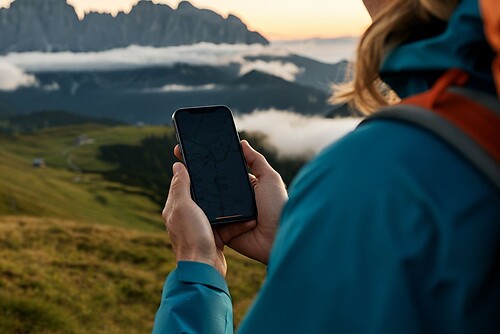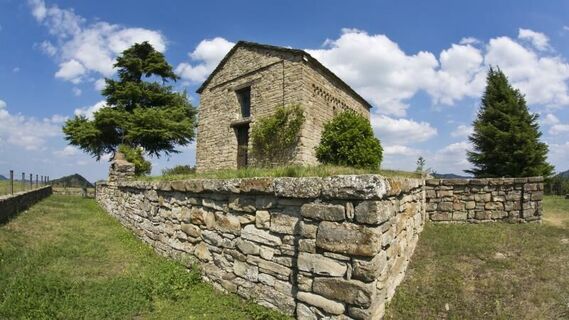GTL | Stage 3 Bergolo - Prunetto
The village of Bergolo practically coincides with the entire village and, with not even 70 inhabitants, is one of the smallest centers in all the Langhe, also in terms of surface area. Always historically...
The village of Bergolo practically coincides with the entire village and, with not even 70 inhabitants, is one of the smallest centers in all the Langhe, also in terms of surface area. Always historically linked to the nearby Cortemilia, from which the Marquises also exercised their power over all the neighboring fiefdoms, it lost its castle already in the late Middle Ages. However, it retains an overall architectural unity, represented above all by the continuity of the building materials, which here are essentially made up of Langa stone. This is why it has always been called the "Paese di Pietra".

From the center of the village, take the road that leads to the campsite and continue flat on the paved road which branches off to the right, near the access to the bungalows and proceeds flat up to an isolated villa. Here you keep to the ridge of the hill and, near a votive pillar, go up to the right up to Bric Massimino, dominated by an isolated farmhouse. The ridge is very narrow and allows you to enjoy the view on both sides at the same time, the gentler one towards the Bormida and the steeper one towards the Uzzone. From this point the road becomes gravel and proceeds, level, into a beautiful chestnut grove . Continue to the right at a couple of crossroads and you reach the saddle above the houses of Levice, a village that we can admire from above. A short detour from the itinerary on the dirt road leads in about a hundred meters to the ruined tower of the town, the first early medieval settlement, then organized further down on the current provincial road, where, in fact, Levice stands today. If you want to make a substantial detour , unsignposted, you can go down to the village. The enclosed village of Levice certainly deserves a visit, retaining a particular sloping checkerboard structure, quite rare in the Langhe (perhaps something similar exists only in La Morra). The square with the parish church of Sant'Antonio Abate, embellished by a beautiful Romanesque bell tower, is completed by the seventeenth-century Palazzotto degli Scarampi which gives it a certain importance. The charm of the village is captured in the cobbled stone "a sternìa", to facilitate the grip of the hooves of mules and horses, and through vaults and shaded passages that connect the steep descents of the village. Continuing instead the path along the crest, after a few meters on asphalt you have to turn sharply to the left and go up a stretch of hard dirt road between two curtains of bushes. Neglect the roads that descend to the right and left to follow the wide, slightly uphill ridge. In short, you reach a crossroads: you pass it and take the paved road, with an adjacent rest area, which, slightly uphill, leads to the panoramic Pian della Croce. Still on the ridge, but on a now gravel road, you still climb towards the top of the hill. Descend for a short stretch and, keeping to the crest, you reach the asphalt on the saddle located on the slopes of Bricco delle Forche. Climb up for a few meters, then, near an aqueduct depot, go down to the right, as far as the crossroads a few tens of meters from Cascina Coste, isolated between cultivated fields and reforestation of conifers. Leave the paved road to go up to the left, on a dirt road, and proceed on level ground among the cultivated fields, on a path that is not very clear, until you reach a villa, which you skirt along to reach, after a few metres, an asphalt road which you must follow proceeding towards right. Go down to the wide provincial road, and, after passing the green area, continue, always keeping to the ridge, up to the hamlet of Serra. At the next crossroads, follow the signs for the castle, to the right, quickly reaching the top of the hill. The village of Prunetto offers a unique panorama, with its magnificent castle, built by the Marquises Del Carretto, which fills our eyes and dominates the hill below. The castle and the adjacent church (Romanesque foundation and originally dedicated to San Lorenzo, today the Carmine Sanctuary) constitute one of the most beautiful monumental complexes in the Langhe. The Sanctuary, expanded several times over the centuries by the foundation attested in the apse around the XII century, preserves remarkable frescoes among the oldest in the valley, as well as a cycle signed Segurano Cigna, master of the Monregalese neo-Gothic school of the century. XV. The castle stands right on the edge of the fortress, probably involved in a collapse that swallowed part of the oldest inhabited area, and preserves the appearance of a surly medieval manor intact. It is then necessary to proceed to the beginning of the low wall that runs along the entrance arch known as "the battling" and go down to the left, on the steep via Castello, to cross the oldest village in the municipality. You will soon return to the provincial road, turn right and continue until you reach the parish church.
Suosittuja retkiä naapurustossa
Älä jää paitsi tarjouksista ja inspiraatiosta seuraavaa lomaasi varten.
Sähköpostiosoitteesi on lisätty postituslistalle.







